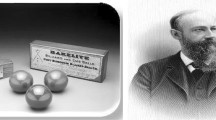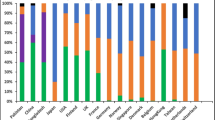Abstract
Introduction
Composting may enhance bioremediation of PAH-contaminated soils by providing organic substrates that stimulate the growth of potential microbial degraders. However, the influence of added organic matter (OM) together with the microbial activities on the dissipation of PAHs has not yet been fully assessed.
Materials and methods
An in-vessel composting-bioremediation experiment of a contaminated soil amended with fresh wastes was carried out. Four different experimental conditions were tested in triplicate during 60 days using laboratory-scale reactors: treatment S (100% soil), W (100% wastes), SW (soil/waste mixture), and SWB (soil/waste mixture with inoculation of degrading microorganisms).
Results and discussion
A dry mass loss of 35 ± 5% was observed in treatments with organic wastes during composting in all the treatments except treatment S. The dissipation of the 16 USEPA-listed PAHs was largely enhanced from no significant change to 50.5 ± 14.8% (for SW)/63.7 ± 10.0% (for SWB). More obvious dissipation was observed when fresh wastes were added at the beginning of composting to the contaminated soil, without significant difference between the inoculated and non-inoculated treatments. Phospholipid fatty acid (PLFA) profiling showed that fungi and G-bacteria dominated at the beginning of experiment and were probably involved in PAH dissipation. Subsequently, greater relative abundances of G + bacteria were observed as PAH dissipation slowed down.
Conclusions
The results suggest that improving the composting process with optimal organic compositions may be a feasible remediation strategy in PAH-contaminated soils through stimulation of active microbial populations.









Similar content being viewed by others
References
AFNOR (2005) Norme française NFU 44–162. Amendements organiques et supports de culture—Fractionnements biochimiques et estimation de la stabilité biologique. AFNOR, Paris
Alexander M (1999) Biodegradation and bioremediation, 2nd edn. Academic, San Diego, p 453
Amir S, Hafidi M, Merlina G, Hamdi H, Revel JC (2005) Fate of polycyclic aromatic hydrocarbons during lagooning sewage sludge. Chemosphere 58:449–458
Antizar-Ladislao B, Lopez-Real J, Beck AJ (2005) Laboratory studies of the remediation of polycyclic aromatic hydrocarbon contaminated soil by in-vessel composting. Waste Manage 25:281–289
Antizar-Ladislao B, Lopez-Real J, Beck AJ (2006) Degradation of polycyclic aromatic hydrocarbons (PAHs) in an aged coal-tar contaminated soil under in-vessel composting conditions. Environ Pollut 141:459–468
Antizar-Ladislao B, Beck AJ, Spanova K, Russell NJ, Lopez-Real J (2007) The influence of different temperature programmes on the bioremediation of polycyclic aromatic hydrocarbons (PAHs) in a coal-tar contaminated soil by in-vessel composting. J Hazard Mater 144:340–347
Antizar-Ladislao B, Spanova K, Beck AJ, Russell NJ (2008) Microbial community structure changes during bioremediation of PAHs in an aged coal-tar contaminated soil by in-vessel composting. Int Biodeterior Biodegradation 61:357–364
Atagana HI (2004) Co-composting of PAH-contaminated soil with poultry manure. Lett Appl Microbiol 39:163–168
Brändli RC, Bucheli TD, Kupper T, Furrer R, Stadelmann FX, Tarradellas J (2005) Persistent organic pollutants in source-separated compost and its feedstock materials—a review of field studies. J Environ Qual 34:735–760
Boonchan S, Britz ML, Stanley GA (2000) Degradation and mineralization of high molecular-weight polycyclic aromatic hydrocarbons by defined fungal–bacterial cocultures. Appl Environ Microbiol 66(3):1007–1019
Cai QY, Mo CH, Wu QT, Zeng QY, Katsoyiannis A, Ferard JF (2007) Bioremediation of polycyclic aromatic hydrocarbons (PAHs)-contaminated sewage sludge by different composting processes. J Hazard Mater 142:535–542
Canet R, Lopez-Real J, Beck AJ (1999) Overview of polycyclic aromatic hydrocarbon biodegradation by white-rot fungi. Land Contam Reclamation 7:191–197
Canet R, Birnstingl JG, Malcolm DG, Lopez-Real JM, Beck AJ (2001) Biodegradation of polycyclic aromatic hydrocarbons (PAHs) by native microflora and combinations of white-rot fungi in a coal-tar contaminated soil. Bioresour Technol 76:113–117
Carmichael LM, Christman RF, Pfaender FK (1997) Desorption and mineralization kinetics of phenanthrene and chrysene in contaminated soils. Environ Sci Technol 31(1):126–132
Carriere PPE, Mesania FA (1995) Enhanced biodegradation of creosote-contaminated soil. Waste Manage 15:579–583
Doublet J, Francou C, Poitrenaud M, Houot S (2010) Sewage sludge composting: Influence of initial mixtures on organic matter evolution and N availability in the final composts. Waste Manage 30:1922–1930
Englert CJ, Kenzie EJ, Dragun J (1993) Bioremediation of petroleum products in soil. In: Calabrese EJ, Kostecki PT (eds) Principles and practices for petroleum contaminated soils, chap. 8. Lewis, Boca Raton
Farenhorst A (2006) Importance of soil organic matter fractions in soil-landscape and regional assessments of pesticide sorption and leaching in soil. Soil Sci Soc Am J 70(3):1005–1012
Francou C, Linères M, Derenne S, Le Villio-Poitrenaud M, Houot S (2008) Influence of green waste, biowaste and paper-cardboard initial ratios on organic matter transformations during composting. Bioresour Technol 99:8926–8934
Frostegård Å, Tunlid A, Bååth E (1993) Phospholipid fatty acid composition, biomass, and activity of microbial communities from two soil types experimentally exposed to different heavy metals. Appl Environ Microbiol 59(11):3605–3617
He YW, Yediler A, Sun T, Kettrup A (1995) Adsorption of fluoranthene on soil and lava: effects of the organic carbon contents of adsorbents and temperature. Chemosphere 30(1):141–150
Joner EJ, Hirmann D, Szolar OHJ, Todorovic D, Leyval C, Loibner AP (2004) Priming effects on PAH degradation and ecotoxicity during a phytoremediation experiment. Environ Pollut 128(3):429–435
Kästner M, Breuer-Jammali M, Mahro B (1994) Enumeration and characterization of the soil microflora from hydrocarbon-contaminated soil sites able to mineralize polycyclic aromatic hydrocarbons. Appl Microbiol Biotechnol 41:267–273
Kästner M, Mahro B (1996) Microbial degradation of polycyclic aromatic hydrocarbons in soils affected by the organic matrix of compost. Appl Microbiol Biotechnol 44:668–675
Kästner M, Streibich S, Beyrer M, Richnow HH, Fritsche W (1999) Formation of bound residues during microbial degradation of [14C] anthracene in soil. Appl Environ Microbiol 1999:1834–1842
Larkin MJ, Kulakov LA, Allen CCR (2005) Biodegradation and Rhodococus masters of catabolic versatility. Curr Option Biotechnol 16:282–290
Lau AK, Lo KV, Liao PH, Yu JC (1992) Aeration experiments for swine waste composting. Bioressource Technol 41:145–152
Lee PH, Ong SK, Golchin J, Nelson GLS (2001) Use of solvents to enhance PAH biodegradation of coal tar-contaminated soils. Water Res 35:3941–3949
Li H, Luo YM, Song J, Wu LH, Christie P (2006) Degradation of benzo[a]pyrene in an experimentally contaminated paddy soil by vetiver grass (Vetiveria zizanioides). Environ Geochem Health 28:183–188
Mahro B, Schaefer G, Kfistner M (1994) Pathways of microbial degradation of polycyclic aromatic hydrocarbons in soil. In: Hinchee AR, Leeson E, Semprini L, Ong SK (eds) Bioremediation of chlorinated and polycyclic aromatic hydrocarbons. Lewis, Boca Raton, pp 203–217
Mathur SP, Dinel H, Owen G, Schnitzer M, Dugan J (1993) Determination of compost biomaturity: 2. Optical-density of water extracts of compost as a reflexion of their maturity. Biol Agric Hortic 10:87–108
Navarrete A, Peacock A, Macnaughton SJ, Urmeneta J, Mas-Castellà J, White DC, Guerrero R (2000) Physiological status and community composition of microbial mats of the Ebro Delta, Spain, by signature lipid biomarkers. Microb Ecol 39:92–99
Olivier P, Rafin C, Reignie E (2004) Bioremediation of an aged polycyclic aromatic hydrocarbons (PAHs)-contaminated soil by filamentous fungi isolated from the soil. Int Biodeterior Biodegradation 54:45–52
Parekh NR, Bardgett RD (2002) The characterisation of microbial communities in environmental samples. In: Keith-Roach MJ, Livens FR (eds) Interactions of microorganisms with radionuclides. Elsevier Science Ltd., New York, pp 37–60
Pignatello JJ, Xing BS (1996) Mechanisms of slow sorption of organic chemicals to natural particles. Environ Sci Technol 30:1–11
Potter CL, Glaser JA, Chang LW, Meier JR, Dosany MA, Herrmann RF (1999) Degradation of polynuclear aromatic hydrocarbons under bench-scale compost conditions. Environ Sci Technol 33:1917–1925
Richard TL, Hamelers HVM, Veeken A, Silva T (2002) Moisture relationships in composting processes. Compost Sci Util 10:286–302
Sadaka S, El-Taweel A (2003) Effect of aeration and C:N ratio on household waste composting in Egypt. Compost Sci Util 11(1):36–40
Sánchez-Monedero MA, Roig A, Cegarra J, Bernal MP (1999) Relationships between water-soluble carbohydrate and phenol fractions and the humification indices of different organic wastes during composting. Bioresour Technol 70:193–201
Sasek V, Bhatt M, Cajthaml T, Malachova K, Lednicka D (2003) Compost-mediated removal of polycyclic aromatic hydrocarbons from contaminated soil. Arc Environ Contam Toxicol 44:336–342
Sims JL, Sims RC, Matthews JE (1990) Approach to bioremediation of contaminated soil. Hazard Waste Hazard Mater 7:117–149
Sverdrup LE, Nielsen T, Krogh PH (2002) Soil ecotoxicity of polycyclic aromatic hydrocarbons in relation to soil sorption, lipophilicity, and water solubility. Environ Sci Technol 36:2429–2435
Van Soest PJ, Wine RH (1967) Use of detergents in the analysis of fibrous feeds. VI. Determination of plant cell constituents. J official chemists 50:50–55
Volkering F, Breure AM, Sterkenburg A, Vanander JG (1992) Microbial degradation of polycyclic aromatic hydrocarbons: effect of substrate availability on bacterial growth kinetics. Appl Microbiol Biotechnol 36:548–552
Wischmann H, Steinhart H (1997) The formation of PAH oxidation products in soils and soil/compost mixtures. Chemosphere 35:1681–1689
Wilson SC, Jones KC (1993) Bioremediation of soil contaminated with polynuclear aromatic-hydrocarbons (PAHs)—a review. Environ Pollut 81:229–249
Willson GB (1989) Combining raw materials for composting. BioCycle 30:82–83
Yang H, Su YH, Zhu YG, Chen MM, Chen BD, Liu YX (2007) Influences of polycyclic aromatic hydrocarbons (PAHs) on soil microbial community composition with or without vegetation. J Environ Sci Health Part Tox Hazard Subst Environ Eng 42:65–72
Zelles L, Bai QY (1994) Fatty acid patterns of phospholipids and lipopolysaccharides in environmental samples. Chemosphere 28:391–411
Zelles L, Bai QY, Rackwitz R, Chadwick D, Beese F (1995) Determination of phospholipid- and lipopolysaccharidederived fatty acids as an estimate of microbial biomass and community structures in soils. Biol Fert Soil 19:115–123
Zelles L (1999) Fatty acid patterns of phospholipids and lipopolysaccharides in the characterisation of microbial communities in soil: a review. Biol Fertil Soils 29:111–129
Zhang HH, Lin K, Wang HL, Gan J (2010) Effect of Pinus radiata derived biochars on soil sorption and desorption of phenanthrene. Environ Pollut 158:2821–2825
Zhang WX, Bouwer EJ, Ball WP (1998) Bioavailability of hydrophobic organic contaminants: effects and implications of sorption-related mass transfer on bioremediation. Ground Water Monit Remediat 18(1):126–138
Acknowledgements
We are grateful to Egide, the French ministry of Foreign Affairs and the Chinese Academy of Sciences for providing financial support for this study through the programs PHC-PFCC and kzcx1-yw-06-03, respectively. We thank Nathalie Bernet and Valerie Dumeny for supplying the PAH measurements in contaminated soil and Muriel Jolly for her assistance in the organic matter analysis (Van Soest).
Author information
Authors and Affiliations
Corresponding author
Additional information
Responsible editor: Zhihong Xu
Rights and permissions
About this article
Cite this article
Zhang, Y., Zhu, YG., Houot, S. et al. Remediation of polycyclic aromatic hydrocarbon (PAH) contaminated soil through composting with fresh organic wastes. Environ Sci Pollut Res 18, 1574–1584 (2011). https://doi.org/10.1007/s11356-011-0521-5
Received:
Accepted:
Published:
Issue Date:
DOI: https://doi.org/10.1007/s11356-011-0521-5




